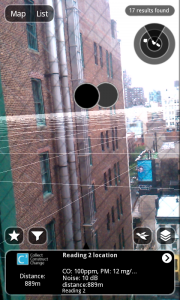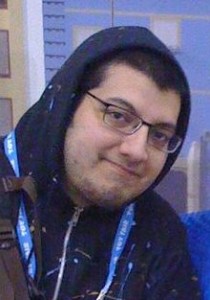By Rachel Signer
 Joe Saavedra graduated from the Design and Technology MFA program in 2010. He now serves as an adjunct lecturer in the same program, teaching Creative Computing, CC Lab, Core Lab: Interaction, “and a Collab studio here and there.” His thesis project, Citizen Sensor, attempts to empower everyday people to collect data about their environments. Here Joe talks about the highlights of his past year at Parsons and what he’s been doing with Citizen Sensor.
Joe Saavedra graduated from the Design and Technology MFA program in 2010. He now serves as an adjunct lecturer in the same program, teaching Creative Computing, CC Lab, Core Lab: Interaction, “and a Collab studio here and there.” His thesis project, Citizen Sensor, attempts to empower everyday people to collect data about their environments. Here Joe talks about the highlights of his past year at Parsons and what he’s been doing with Citizen Sensor.
What was one of this year’s highlights for you?
Definitely going to the Design Indaba conference in Cape Town, South Africa, in late February. It was the first time I’d been to Africa. It was really excellent. The main talk I gave was part of a panel of students who were representing different countries all over the world.
They had big names there, like Ben Fry – one of the inventors of Props Names, which is a coding environment for designers. I teach his program at Parsons so I was really excited. Also Charlie Todd from Improv Everywhere – they do flash mobs.
Did they pay for you to go?
Yes, the whole thing.
How can someone at Parsons get to go to this conference?
Design Indaba has relationships with a bunch of universities, like RCA in London, a couple schools in Switzerland, and so on. Parsons nominates a couple of students every year and then they choose.
What else is new in your life?
Soon I’m heading to China [with a group from Parsons] to work on a project called Weather Tunnel. We’re going to set up an installation space with several partner universities from all over the world. Everyone is making an installation that is dynamic and entirely controlled by weather and environmental data. I’ve been developing units that have a bunch of sensors on them that measure light, temperature, humidity, ambient noise, carbon monoxide and dioxide, and smoke. Every university has received one of these sensors in the past few weeks.
How will it work?
So they plug them in and add an Ethernet cable and the real-time information goes into an online database. Info is pulled every 2 minutes. We’re using this system called Pachube.
I pretty much modified my designs for Citizen Sensor to be a stationary unit for this project.
It’s about making pieces that are directly related to the environmental data, and hopefully making some sort of statement.
Like what kind of statement?
With that data you could compare places, like Helsinki to Perth – just comparing their carbon dioxide levels on a daily basis, and also how it changes over the course of a day.
When I made Citizen Sensor, it was about creating a tool that empowers people to build their own told & measure their own data – instead of relying on public statistics, which are old and unreliable. With CS the idea is that you’re taking control of your data.
What’s the potential of using something like Citizen Sensor to combat climate change?
Last summer I worked with the New York Hall of Science, in Queens – a giant science museum for elementary and high school students. It was a summer camp, and we had 25 middle and high school students. We went out and collected data with the sensor units – the sensor units talk to cell phones which send data up into the clouds. We’d go, for example, behind a school bus. Then we ended up hooking it up to augmented reality – where you can use your phone to look at the world, and you can see data visualized onto the picture of what you’re looking at.
How did the kids react to the technology?
They were super excited. I was worried that it would be above their heads. But they jumped right in. They wanted to know how everything was working.
As part of the curriculum I developed a module where we sat down with the kids and built sensors. So each child built a sensor and connected it to an LED – they would change from green to red based on the data. It was a dumbed-down version. Every student made their own and took them home.
I think education is a huge area where this kind of technology can do a lot of good, and where there are a lot of resources available. Just today I heard from the NY Hall of Science and they want to continue developing the program, I’ll just be a consultant on it now.
And what’s in the future for Citizen Sensor?
I’m not really interested in creating a commercial product. I’m more interested in making tools and processes and documenting them – so that other people can use the ideas.
I’m a big fan of the Open Source Movement. I heard of it almost three years ago, when I started my MFA. Open Source is about publishing your work, and documenting – not just things like code, but also the processes that you’re using and the hardware. Open hardware is a newer standard that’s now gaining popularity. You share everything, your designs, your schematics. People can use your work and adapt it to whatever they’re making.
 What if someone patents Citizen Sensor and makes millions of bucks off it?
What if someone patents Citizen Sensor and makes millions of bucks off it?
I used almost all open source tools to create it in the first place. My entire kit was built with the Arduino Platform, an open source hardware prototyping platform. So I took the design files and created them from scratch with my own circuit board – I prototyped it many times – but then I came out with hardware that was specifically tailored to my application.
How was your experience at Parsons and how did it prepare you for the real world?
I learned sooo much. For example – Citizen Sensor – it’s a really deep project because it’s not just hardware, it’s software, and web-based software on top of that. AMT is super unique because they offer classes in all of those things. The enormous diversity within the program is both a strength and a weakness. If you are willing to work your butt off, you’re going to learn so much. If you come and you just want to become a server admin, and do server maintenance, you can do that – but AMT really exposes you to different types of technology and expands your horizons: 3d modeling, digital graphics, motion graphics –stuff like this.
Last November I went to Germany and won an award, and this conference in South Africa, and this China project – all of those things were because of Parsons, and I am extremely grateful for those opportunities. Parsons has a lot of international connections.
Interview has been edited and condensed.

